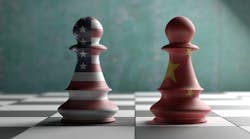Changes in the Ex-Im Bank Would Bring Tech Jobs Back to the US: Commentary
The U.S. government’s Export-Import Bank is an $8 billion investment machine that helps American companies find new export opportunities around the world. However, some of its rules are now making it impossible for the Bank to support America’s technology industry, a sector that is vital to the U.S. economy, national security, and millions of jobs.
The Ex-Im Bank has new leadership, including CEO Kimberly Reed, and is in the midst of a comprehensive review of its rules. This is the right time to introduce needed flexibility so that the Bank can help bring technology manufacturing jobs back to the U.S., and provide a vital counterweight to China’s ambitions in the global tech arena.
The Ex-Im Bank should consider two innovations. First, it should establish national-security-sensitive sectors under which it can lend with maximum flexibility to support U.S. companies against Chinese competitors. This should include wireless networks such as the dozens of 5G telecom contracts now coming up around the world. Today, the U.S. has three small startups eagerly competing with global giants to build wireless telecom networks. However, these complex deals involve a lot more than just networking equipment. Typically, a telecom company in an emerging market like Africa or South America, or in a small Asian country, doesn’t just want to buy networking equipment. It also needs the network company to provide a single package—build cell towers, provide electricity generation, hang antennas, build control rooms, install servers, etc.
But here’s the crucial part: the local telecom company expects 100% financing for the entire project. In a typical $50 million project, the U.S. networking company’s equipment may only comprise 10% of the deal’s value. And of that 10%, most of the hardware isn’t manufactured in the U.S. Yet Chinese network vendors like Huawei are almost always ready to provide full financing.
If the United States is serious about competing with predatory state-owned companies like Huawei that are backed by the full force of the Chinese Communist Party—plus the China Development Bank, the Belt and Road Initiative, and a dozen other state-controlled Chinese financial institutions—then it needs to get serious about backing America’s high-quality wireless telecom companies. These small startups hold the promise of growing and evolving into billion-dollar companies that can compete with China and the other major players.
The same goes for other sectors like the solar power industry. Thanks to recent Section 201 tariffs, the U.S. now has a growing solar panel industry that is manufacturing world-class products in Georgia, Ohio, and elsewhere. But China isn’t standing still. The Chinese government is investing billions in solar cell technology, polysilicon manufacturing, and other parts of the solar chain to establish dominance and drive U.S. contenders into bankruptcy.
I speak from personal experience. For six years, at a Silicon Valley networking company, I competed against Huawei. It’s impossible to compete on the merits of a product when the Chinese government has turned it into a financing competition. You can read more about competing with China here.
In national security situations, the Ex-Im Bank should provide full financing, so long as the project is led by a U.S.-based technology company. Although most of the technology hardware is not yet manufactured in the U.S., each of these tech companies employs hundreds of engineers and other professionals.
In the last 30 years, the U.S. has lost the vast majority of its technology manufacturing capability—and much of it to China. The only way to rebuild is to start by backing U.S. technology companies in the most critical sectors, help them establish themselves, and then provide incentives to bring manufacturing back.
What of other technology sectors? Right now, the Ex-Im Bank is getting inundated by America’s large technology companies—like Cisco and HP—that want rule changes to support their businesses. These companies have offshored the vast majority of their manufacturing to Asia, laid off 10s of thousands of Americans, and in the case of HP, recently told investors they are suffering from the difficulty of getting parts out of China due to COVID.
Yet despite all their faults, these large tech companies still remain our best hope for rebuilding America’s tech sector. The Ex-Im Bank should set standards for helping them in situations that are not national security-sensitive. It should establish three conditions for its finance: at least 50% of the manufactured content is American-made; less than 10% of the product value is made in China; and the company must provide and publish plans to expand its U.S. manufacturing base in a reasonable timeframe of one to three years.
The Ex-Im bank is in a unique position to set those objectives and inspire companies to step up. The goal is to break the U.S. technology sector’s current conviction that manufacturing must be done in Asia. Many mid-level executives at tech firms agree privately with this logic. They recognize the threat of China and they know that eventually engineering jobs will migrate to manufacturing locations.
An old friend of mine who runs a space technology company told me recently that he was unable to win Ex-Im Bank financing for a foreign deal because not enough of the parts were made in the U.S. This was despite the fact that his company employs hundreds of Americans and plays a key role in U.S. leadership in space technology. Luckily, he was able to win French export credit agency support for the deal. The French government agency takes a more flexible, long-term view.
Washington must take a similar approach. We have to understand that since 2010, the U.S. has fallen to the number two manufacturing nation in the world. When you’re number two, you have to be more creative.
Jeff Ferry, @menloferry, is chief economist at the Coalition for a Prosperous America.




